Wonder Woman #1 (DC, $2.99)
By Devon Sanders
Wonder Woman is the rare character where the idea of Wonder Woman may actually be stronger than anything ever actually done with Wonder Woman. At least once a year, you hear the rumblings; someone is thinking of taking the character Lynda Carter made famous to “all-new heights,” with it all usually amounting to nothing more than lip service. Well, that’s until recently when lip service produced a nearly un-filmable WW movie script, a dead on arrival TV pilot and a comics re-launch written by someone known for actually not finishing much of anything he’s started. Basically, Wonder Woman has been made more symbol than character. A symbol of childhoods past, an idea held back by what everyone believes Wonder Woman should be as opposed to what the character could be. So… you ready for another Wonder Woman re-launch?
A young woman sleeps quietly while the gods of Olympus go about their lives. On a Singapore rooftop, Apollo speaks of a great vengeance ready to touch down upon Earth. This young woman’s life is about to change, she is to be a mother and for this she must be punished. As they go about playing their games, a familiar champion is thrust to the fore, ready to defend human life against the wrath of the gods.
Writer Brian Azzarello puts together a taut storyline playing heavily on Greco-Roman mythology and largely succeeds. You never see much of the gods but their presence is certainly felt and Wonder Woman, accustomed to their ways, comes across as always ever-ready while weary of playing this game. There may be some metatextual commentary going on here but Azzarello presents as something oddly vital Wonder Woman’s story. Fans of Azzarello’s past 100 Bullets work will find plenty to latch onto here as he presents the gods’ wrangling and toying with human lives very much in the light of the 13 houses of The Trust, where when you really think about is a very intriguing juxtaposition.
Artist Cliff Chiang takes his storytelling to new levels employing a sketchier, jagged line that serves this story well. Chiang’s pacing and layout is spot-on, letting the story flow to its natural conclusion while his character designs for the gods absolutely steal the show. Chiang just may, artistically, be the best thing to happen to Wonder Wonder since legendary artist George Perez’s turn some twenty-years ago.
In Wonder Woman #1, you’ll find all the things you’ve come to expect from a Wonder Woman comic. Plenty of action, lots of tension. Only this time around, good intent is replaced by things actually happening and the promise of story, something Wonder Woman comics haven’t seen in a good long while.
Rating: 




Out of a Possible 5 Stars
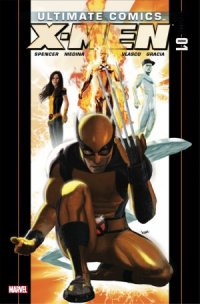 Ultimate Comics X-Men #1 (Marvel, $3.99)
Ultimate Comics X-Men #1 (Marvel, $3.99)
By Jeb D.
The superhero comic / soap opera comparison doesn’t always sit well with comics fans, but that’s mostly due to the term “soap opera” seeming like code for “romance” for a lot of readers. While superhero comics certainly have their share of romance, where they really appropriate the advantage of soap operas is in their long-form storytelling, with interlocking relationships and the potential for character growth. A good installment of either superhero comic or “daytime drama” should have plenty happening in the present tense, while taking its time to unfold a larger storyline. In the world of comics, of course, we’ve come to suspect all such writing as “decompressed” or “written for the trade,” and obviously, not every writer can hit the mark with that sort of pacing. In this relaunch of the original “Ultimate” franchise, Nick Spencer deftly lays out the new landscape in which the remaining X folks will be operating, lays seeds for plots and perils, gives quick character sketches, and at the end of the issue, you know pretty much where everyone stands and why you’ll want to keep reading. One caveat, though: that bit about things “happening in the present tense”? Not what you’d call a lot of action in this one.
Between Ultimatum and Ultimate Fallout, the Ultimate U has had a major deck-clearing, much of it affecting the X-Men; envisioning a Marvel X environment that lacks, among others, Cyclops, Magneto, Professor X, and the “real” version of Wolverine, is a marketer’s nightmare, but a great opportunity for writers who want to play “What If?” with the basic concepts.
In the Ultimate U, the mutant condition has been discovered to be, not a genetic inheritance, but the result of medical experimentation by the government, a “mistake” which is going to be rectified by hunting down mutants, isolating them in camps, and generally trying to forget that it ever happened. It’s a nice twist on the usual race/gender tolerance issues: our heroes are despised not simply out of fear and ignorance, but guilt… and the knowledge among those responsible that they may not all go quietly. Jean Grey, in her alias as Karen Grant, has taken on Xavier’s old mantle of seeking out young mutants, and the book opens with her paying an in-home visit that ends with a devastating gut-punch, making it clear that Spencer’s not kidding around. We get glimpses of the current states of familiar faces like Storm, Colossus, Nick Fury, and Kittty’s band of proto-Runaways; Val Cooper’s press conference, intercut throughout the issue, provides exposition. Spencer makes good use of the brief appearances of the cast members: even the wordless segments give effective character insight, and the last line of the comic is so melodramatically ominous and heavy with portent that it warms the cockles of the old-school heart.
The art by Paco Medina and Juan Vlasco, with colors from Marte Gracia, is a little on the variable side: the facial work can be inconsistent from page to page, even though they’re generally expressive; overall, it feels just a bit cartoony for the tough, aggressive launch to this story. But the backgrounds are clean and with just enough detail not to derail the story, the color palette is nicely chosen, and the chase scene involving Rogue is handled vigorously.
As the first chapter of this new version of the X-Men saga, this should leave you wanting more, and it definitely does. However, one could reasonably argue that it wouldn’t have killed Spencer to, in fact, give you a little bit more—at least more action—in this issue.
Rating: 




Out of a Possible 5 Stars
The Last Mortal #1 – 4 (of 4)(Image/Top Cow, $3.99 ea)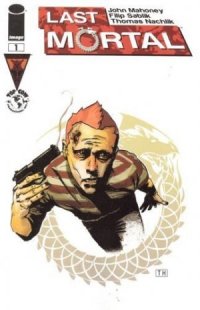
by Graig Kent
The Last Mortal is a breezy, novice conspiracy thriller with a slight supernatural twist, By supernatural twist, I mean that there’s one fairly significant MacGuffin in the works by way of a character who seemingly can’t die. By conspiracy thriller, I mean that the starting events of the story aren’t exactly what they seem, and as the story progresses the characters and audience begin to see the bigger picture. By breezy, I mean that it’s fast-paced with a strong forward momentum that even the flashback sequences don’t hold up too much. By novice, I mean that its the first major effort from the creative team and that it’s a glossy and polished end product that features, by and large, a story that doesn’t seem very fresh. But even still the writer team of John Mahoney and Filip Sablik deliver a competent and engaging script for a book that, despite its familiarity, does manage to deliver a few surprises.
Mahoney and Sablik’s story finds two college dropouts-turned-street hustlers in over their heads, as a debt that they can’t possibly pay back turns into a hit job on a local mayoral candidate. The hit goes wrong, one man, Brian, is killed, the other, Alec, is left running for his life and full of remorse over the loss of his best friend. The situation grows dire, but Alec discovers, repeatedly, that he can’t die. Situation after situation falls upon him, moment after moment where he should be dead, instead he continues to keep going, discovering further pieces to the puzzle of why his friend is dead and why he’s a marked man.
The conspiracy aspect is detectable a mile off, and Alec’s revenge motivation is fairly cookie cutter, but the progression of the story is handled exceptionally well (mostly, there’s a story segment involving the mayor’s wife that stretches credibility, but does have a nice payoff). Where the story doesn’t succeed so well is in the flashbacks, which primarily take place during Alec’s college days with Brian. These flashbacks intend to define Alec and Brian’s relationship but the opening sequence of the first issue does that fairly well, and the “origin story” of Alec and Brian eventually counter-serves the story, leaving the reader to wonder how Alec could stand being friends with Brian, never mind getting so upset about his death as to do the things he does over it. As well, there’s no real insight into Alec’s seeming immortality, how it manifested, details of which probably would have better served the series than the many flashbacks.
Thomas Nachlik handles the art chores on the book, using what appears be a photo-manipulation/computer-tracing technique. I really dig the aesthetic of this technique, and at a cursory glance, it’s extremely visually striking. However, the storytelling suffers for it. Every panel feels posed for, and at times the figures seem detached from their settings, like they’re not inhabiting their environment. As a result the book has a realistic feel in one regard, but a falseness in another, a surreality that never seems quite right. The closest thing I can compare it to would be like a black and white version of Tom Goes To The Mayor, one that’s a conspiracy thriller and not a goofy surrealist comedy. Nachlik’s covers (with assist from Dave McCaig) seem more like original drawings than photo-manipulation, and have a real Jonathan Hickman-esque design quality to them. They’re very striking.
With the exception of the ill-advised flashback sequence, the final issue has an incredibly well-executed end game, one that goes a long way to justifying the path that led to it. Mahoney and Sablik provide creators commentary at the end of each book, focusing on a facet of the book or its history, and here they discuss working out their finale, and it’s obvious that they put the right amount of thought, stress and effort into it and came to the best conclusion imaginable.
Rating: 




Out of a Possible 5 Stars
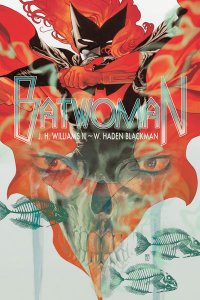 Batwoman #1 (DC, $2.99)
Batwoman #1 (DC, $2.99)
By Adam Prosser
Usually, when reviewing comics for this column, I—and for the most part, my fellow columnists as well—focus pretty much exclusively on the writing. I sometimes manage to squeeze in a comment on the visuals, or at least acknowledge the art team, but for the most part, writing up the artwork feels like a bit of a sidebar from whatever points I’m trying to make in my review, and as such it often gets trimmed. More than that, art sometimes demands a level of appreciation that’s not entirely compatible with trying to generate reviews on time for this column, so I sometimes feel it’s more appropriate to keep my mouth shut about it unless some aspect really jumps out at me.
I feel bad about that, though. Comics aren’t novels. The visuals are vital to the medium of comics, and if artwork has started to feel incidental—merely a means to tell the story—then that’s actually something that should be commented on. The mainstream publishers have always tended to enforce a “house style”, but it’s almost impossible for an artist not to put his or her unique stamp on material, and sometimes even a little glimmer of personality makes all the difference.
J. H. Williams’ art features more than a glimmer of personality. He’s often cited as the best artist working in comics today, and he’s undeniably one of the most distinctive. After relaunching the character of Batwoman in Detective Comics last year with writer Greg Rucka, Williams takes over as both writer (with W. Haden Blackman, apparently best known for writing Star Wars comics) and artist, it was immediately clear that the book would be one of the best-looking on the stands.
The plot here is all set-up: we’re reintroduced to Kate Kane, gothy trust fund baby and oh-by-the-way-she’s-a-lesbian, who secretly fights crime as Batwoman. She’s still recovering from discovering, in the previous series, that her twin sister, thought dead, had become a supervillain and that her dad, an army colonel who used to be her de facto Alfred, had kept this knowledge from her, a fact which has driven a wedge between them. Meanwhile she’s adopted a new sidekick named Plebe, is investigating a mysterious case in which children are being kidnapped by a supposed ghost, and is unwittingly being tracked by an ominous government agency.
The story of the new Batwoman, while it has a few interesting wrinkles (such as that “crime bible” business from the Rucka-written storyline, not mentioned in this issue) has been pretty straightforward from the beginning; this is clearly an art-driven book, emphasizing pure sensation over narrative, just like comics used to do back in the Silver Age. This isn’t inherently a good or a bad thing, but with Williams in the driver’s seat, of course, the art *is* the story. Williams continues his gimmick of switching art styles depending on what story thread we’re following—the two pages in the DEO (Department of Extranormal Operations) have a shadowy, Mike Mignola-ish look, the scenes where the ghostly villain makes her appearance have a lush, watercolour style with free-flowing panel borders, and the flashbacks to previous events have a harshly delineated, almost documentary feel. Plus, of course, there’s the flat but colourful, almost “Little Nemo”-ish artwork withint conservative panel borders for Kate’s everyday life, contrasted with lush, vibrant artwork and extravagant compositions for the scenes in which she’s Batwoman.
I say “switching”, but Williams doesn’t simply flip around between styles, he integrates them together, such as the two-page spread in which the flashbacks peek up over a diagonal spread of Kate confronting her dad, with Batwoman looming over everything. In Williams’ hands, the layout of the page is another device to tell the story. This has its upsides and downsides; the purely narrative flow of things like action sequences is sometimes compromised by these complex spreads, but then, it’s arguable that by the nature of comics, the initial impact of a sequence isn’t as important as it is in movies or TV, when you can take the time to scan the page and figure out what’s going on. Nevertheless, from a purely narrative point of view, this story could be a little bewildering to a new reader—yet another of the New 52 that botches that particular opportunity.
Still, there’s no other book like this on the stands, and it’s so refreshing to see a book that backgrounds continuity and other wankish fan concerns for pure sensation. Whereas so many superhero books make art subservient to the story, this book flips the dynamic around, shaking up the status quo and giving us a glimpse, however brief, of how comics could be. If the common complaint about comics is that you can blow through them in ten minutes, maybe providing comics that can be appreciated like a museum gallery will help provide us with our money’s worth.
Rating: 




Out of a Possible 5 Stars
Blue Beetle #1 (DC Comics, $2.99)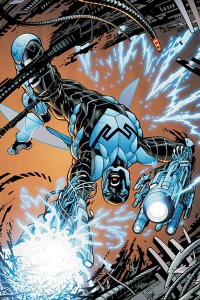
by Graig Kent
One of the things that has surprised me about the New 52 (and it’s neither a good nor bad surprise) is the lack of origin stories in these plentiful first issues. While perhaps not in media res in the strictest sense, the bulk of these firsties are introductory to the character but not outright defining where a character gained his power. Blue Beetle is only the second of these books I’ve read (Grifter being the first) that’s outright started from scratch with the character in its debut issue. Many of the ideas from the pre-relaunch Blue Beetle series are captured once again, from the cast of characters (Jaime, Paco, Brenda) to the Green Lantern adversaries the Reach, only they are tweaked slightly. If you’ve seen the Blue Beetle-centric episodes of Batman:The Brave and The Bold cartoon, it’s equally as familiar, yet not quite the same.
While on the one hand so very little is different about this relaunched Blue Beetle it’s almost a wonder why it’s not just continuing the character’s adventures, especially considering how new the Jaime incarnation of the character is, yet at the same time, coming out the gate with a new origin story seems like the perfect strategy for these New 52 books, and it actually works here, and works well.
Tony Bedard is a solid writer, never too flashy, challenging or provocative, he cranks out decent story after decent story that works generally quite well in the scope of a shared universe, but nothing that ever truly surprises. His work here on Blue Beetle is much the same, setting up numerous plots effortlessly, introducing the immediate bad-guys (the Brotherhood of Evil), the larger-scale bad-guys (The Reach) and the big bad (Brenda’s mob boss aunt). Bedard handles the Puerto Rican community aspect nicely as well, making it a natural setting rather than a pointed one that screams “look! diversity!” Ig Guara impressed me with his work on the various Pet Avengers mini-series, and while I found the humans to be distractingly cartoony next to the rather natural looking animals he was drawing there, it’s so much less of an issue here with barely an animal in sight. In a strange reverse from the norm, his work in plainclothes is actually much better than the tights and spandex crowd. He’s not quite Rafael Albuquerque but he’s still a really good fit for the character.
My main disappointment with the new Blue Beetle (and the entire New 52) is that every title is rated “T Teen” and that there’s no younger reader books here. While Blue Beetle is relatively clean and I could hand this issue off to my 9-year-old, I’m not sure about the next one, or the series as a whole. Not to pigeonhole the character (who’s been given a major boost from his animated appearances), or Guara’s art, but I was hoping this would be a bit more of an all-ages book, a gateway or transitional book from kiddie comics to the DCU-at-large. That DC hasn’t thought to put any such title in their line is one of my biggest frustrations of this initiative.
Rating: 




Out of a Possible 5 Stars
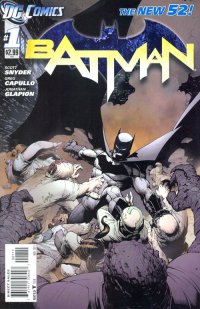 Batman #1 (DC Comics, $2.99)
Batman #1 (DC Comics, $2.99)
By Devon Sanders
I suppose I could sit around and gush about how good Batman #1 truly is. For one, it’s got Batman in it so it’s already one-up on the competition. Two, it has, Scott Snyder of American Vampire fame, a truly smart writer who gets that Batman is an intriguing character who’s best served by stories that challenge the ready and keep them guessing. Three, it has Greg Capullo, late of Spawn and Haunt, an artist I’ve been waiting for nearly 20 years to do something I’d actually be interested in reading. These three factors, combined, have put together a tale that 100% lived up to my expectations and more. So, yes, I could gush and I think I have but if you need further proof, here’s a review:
The denizens of Arkham Asylum are met at the gates by Batman. It’s one against dozens and as always, Batman has a plan. They are defeated through years of preparation and an understanding of the criminal mind. This understanding will be turned on its ear by a final panel so shocking, I realized, seconds after I put Batman #1 down, I was already wishing I had the next issue in hand.
Writer Scott Snyder simply gets what makes Batman great. His is always one step ahead but Snyder smartly throws the character a curve that will call into play everything he knows and will absolutely his faith in all he thinks he knows. It’s an intriguing “What If…?” that fans of all things Batman have asked themselves and under his watch, with clever dialogue and plotting, Snyder delivers.
Artist Greg Capullo proves worth the wait. His Batman is a thing of fluidity and menace to Gotham’s criminals and is a joy to watch. Capullos’s page layout and use facial expression absolutely steal the show and no better illustration of this can be found than in a largely wordless two-page spread of The Bat-Cave. It is truly a thing of beauty and from that page on, all I could do is hope he sticks around for a while.
With Batman #1, Snyder and Capullo spotlight all of the things that make Batman great. From Batman’s handling of Rogues Gallery to a single panel of the Bat-Boys of Bruce, Dick, Tim and Damien together, they hit all the right marks that every Bat-fan, smart, new and old needs to see and then some.
Rating: 




Out of a Possible 5 Stars
Captain Atom #1 (DC Comics, $2.99)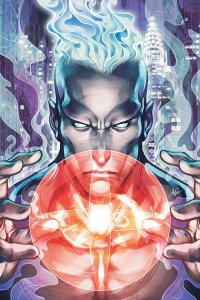
by Graig Kent
With a character like Captain Atom, one who hasn’t held his own title in two decades, one who doesn’t really have much exposure beyond the comics he appears in, one who doesn’t have a distinctively defined character, powers or aesthetic, you really need to bombard your audience out of the gate with something, anything that will make you take notice. For 19 pages of this book, there’s not really a whole lot to take notice of, and by the time the final page hits, where the character is obviously about to take a drastic shift, it’s almost too late.
J.T. Krul reinvents Captain Atom for the New 52 but he didn’t really give him much of a personality. There’s an internal monologue running through the book that at times borders on philosophical but none of it really reveals much about his character, why he is the way he is, why he does what he does… he’s still a void. The story finds his powers shifting, now having the ability to molecularly transform items (honing in on Firestorm’s nuclear man shtick), only when he does, he starts to dematerialize himself. He’s warned that using his powers could cause him to lose molecular cohesion altogether. Guess what happens?
Freddie Williams II has drastically changed his style since last I saw his work, his lines are a a lot softer and looser, his inks heavier, taking on a style reminiscent of Jean Paul Leon. It’s really not what I was expecting from him, but I like it. It’s a good fit for this book, which features a lot of transforming molecules, to have the lines kind of coming apart a little bit.
It’s a decent read, but it really needs to define itself in the second issue to make a stronger impression if it hopes to survive.
Rating: 




Out of a Possible 5 Stars
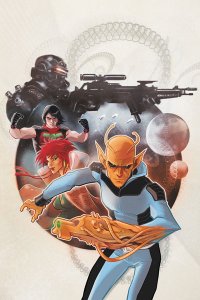 Legion Of Super-Heroes #1 (DC Comics, $2.99)
Legion Of Super-Heroes #1 (DC Comics, $2.99)
by Graig Kent
The Legion of Super-Heroes has been rebooted so often that it comes as a total surprise that in this DC-wide soft revamping of their entire line, the Legion has been left relatively unscathed. It makes sense, since it was only a couple years backthat DC reset the Legion to how they were back in the early 1980’s at the peak of their success, even putting them back in the hands of writer Paul Levitz, who was President of DC during most of the years in between writing the title. The Legion, after numerous iterations, finally felt at home again, and Levitz seemed to have not missed a step from the decade away from writing the plentiful characters on the team. So then why does this new Legion Of Super-Heroes series, which continues on from the series that ended last month, with Levitz still in charge, feel so awkward?
Having skipped the non-Levitz-penned Legion Lost last week, it seems that some, if not most of the events of this book depends on having read that book. I could be mistaken, but if I am, then I have no idea why this book feels like it’s picked up in the middle of a set-up for a new storyline instead of at the beginning. There’s a lot of exposition here, and yet still not enough to tell me what is going on with any clear understanding. As an introductory issue, it’s a failure as it doesn’t introduce the characters or the team all that well. If ever a book needed an introductory “what’s come before” page, it’s this one. There’s copious amounts of drama, as the Legion is so frequently steeped in, yet little of it seems interesting, and when the action finally amps up, I’m wondering what the purpose of the fighting is, so unclear are the motives of this story.
It may just be a transition pain, but it’s a debilitating one. The Legion loyal will no doubt be happy that they haven’t been subjected to another total reboot, but I can’t see this earning the title any new fans.
Rating: 




Out of a Possible 5 Stars
Supergirl #1 (DC Comics, $2.99)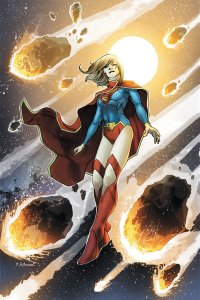
by Graig Kent
I can think of at least four different iterations of Supergirl in the mainstream DCU in the past 30 years. That’s not a very long average shelf life for each version of the character. Unlike Barbara Gordon as Batgirl, Supergirl hasn’t really been popularized in the mainstream as one specific identity or image. At best she’s known as Kara, Superman’s teenaged cousin, escaping Krypton at the same time as baby Kal-El, but arriving on Earth much later. She doesn’t have a defining personality, nor a popularized secret identity. She’s often used as a substitute for Superman which never really helps her to differentiate herself any. This isn’t to say that good stories haven’t been told with her, but she is a rather blank canvas for any writer to come along and fill in.
Michael Green and Mike Johnson embrace the traditional aspects of the character for this first issue, thrusting a teenaged Kara upon Earth, completely disoriented, unaware of where she is, why she’s there, who these strange-talking people in mechanical armor are, and why she’s suddenly so super strong and able to shoot fire from her eyes. Their narration of Kara’s inner monologue is very well executed, conveying her surprise and her fear while also offering hints as to Kryptonian life and establishing the framework of her character – tough yet vulnerable – and quite obviously still a teenager.
The art by Mahmud Asrar (with ink assists from Dan Green and lavish coloring from Dave McCaig) is absolutely gorgeous. Asrar has done a phenomenal job on Kara’s character design, retaining a roundness to her face signifying youth (she has an early-Buffy Sarah Michelle Gellar look to her), while also giving her style with a modern haircut and a very angular costume (whether it’s his design outright or a modification of another design isn’t relevant. Her new costume, odd boots and all, looks far better than Superman’s redesign). As a result, Supergirl isn’t sexualized like she’s been in the recent past. There’s no belly shirt or ass-out mini-skirt and Asrar never does any awkward torso-twisting to get a butt shot.
It’s an engaging first issue, and probably the cleanest, leanest story of the New 52. I’m not certain if this will be the definitive Supergirl comic, but it’s off to a great start all the same.
Rating: 




Out of a Possible 5 Stars